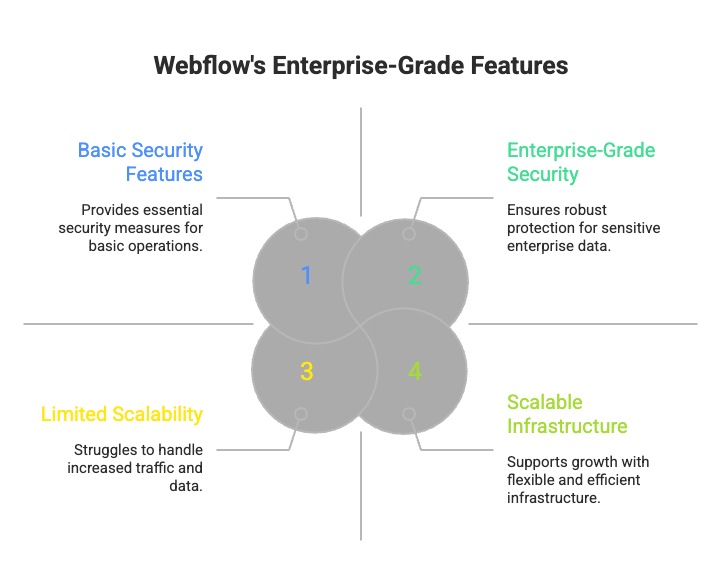In 2025, Hong Kong’s enterprises are evolving beyond traditional websites to adopt scalable, secure, and integrated digital platforms. With increasing customer expectations, competitive business environments, and the demand for faster development cycles, businesses need tools that allow for flexibility, innovation, and rapid deployment.
Among the many solutions available, Webflow has emerged as a game-changing platform, providing enterprises in Hong Kong with the ability to build enterprise-grade digital platforms that go beyond just websites. Its low-code interface, robust CMS, and enterprise-level scalability and security make it an ideal choice for businesses looking to future-proof their digital strategies.
In this blog, we will explore how Webflow empowers enterprises in Hong Kong to create digital platforms tailored to their unique needs. From e-commerce solutions to web apps and internal systems, we’ll dive into Webflow’s advanced capabilities, integration options, and real-world use cases.
Why Hong Kong Enterprises Need Enterprise-Grade Digital Platforms
Hong Kong is a hub for finance, retail, e-commerce, and logistics, and the region’s businesses are increasingly relying on digital platforms to stay relevant and competitive. Here’s why enterprises are moving beyond websites to adopt enterprise-grade digital solutions:
1. Customer Expectations Are Higher Than Ever
Today’s customers demand seamless digital experiences, from blazing-fast load times to personalized interfaces. Basic websites often fail to meet these expectations, prompting businesses to adopt dynamic platforms that cater to diverse customer needs.
2. Scalability Is a Must for Growth
As businesses grow, their digital platforms must handle increased traffic, complex workflows, and vast amounts of data. A platform that is not scalable can hinder growth and lead to poor user experiences.
3. Integration With Existing Tools Is Essential
Enterprises often rely on a suite of tools, such as CRMs, payment gateways, and marketing platforms. A digital platform must seamlessly integrate with these tools to enable smooth operations.
4. Security and Compliance Are Non-Negotiable
With increasing cybersecurity threats, enterprises in Hong Kong—especially in industries like finance and healthcare—need platforms that prioritize data security and compliance with international standards.
5. The Shift Toward Low-Code Solutions
The demand for low-code/no-code platforms is rising globally. Platforms like Webflow empower enterprises to develop robust solutions faster without requiring extensive IT resources, enabling businesses to keep up with market demands.
What Makes Webflow Enterprise-Grade?
While Webflow is often recognized for its intuitive website building tools, its enterprise features make it a robust platform for complex digital projects. Let’s break down what makes Webflow stand out for large-scale use cases in Hong Kong.
1. Unmatched Scalability
Webflow’s hosting infrastructure is built on Amazon Web Services (AWS), ensuring it can handle high-traffic scenarios. Whether you’re launching a marketing campaign microsite or running an e-commerce store, Webflow’s architecture ensures fast load times and high uptime reliability.
Key Features:
- Global CDN: A global Content Delivery Network ensures fast delivery of content to users across Asia-Pacific and beyond.
- Guaranteed Uptime: Webflow offers enterprise clients 99.99% uptime SLAs, ensuring business continuity even during high-demand periods.
- Auto-Scaling: Webflow scales automatically to handle traffic spikes, making it ideal for businesses with fluctuating traffic.
2. Enterprise-Grade Security and Compliance
Security is a top priority for enterprises dealing with sensitive customer and business data. Webflow’s enterprise security features make it a reliable choice for industries like finance, healthcare, and e-commerce.
Security Highlights:
- SSL Encryption: All Webflow sites come with SSL encryption, ensuring secure data transfer.
- ISO 27001 Certification: Webflow adheres to global standards for information security management.
- DDoS Protection: Built-in Distributed Denial of Service (DDoS) protection safeguards platforms from cyberattacks.
- GDPR Compliance: Webflow ensures compliance with General Data Protection Regulation (GDPR) for businesses handling data from EU customers.
3. Advanced CMS for Dynamic Content
Webflow’s Content Management System (CMS) is designed to handle the needs of enterprise clients. It enables businesses to manage and display dynamic content with ease, making it perfect for platforms that require frequent updates or customizable data structures.
CMS Features:
- Custom Collections: Create and manage dynamic content, such as product catalogs, case studies, or real-time updates.
- API Access: Automate workflows and integrate Webflow with third-party tools using its CMS API.
- Multi-User Collaboration: Teams can edit, review, and publish content simultaneously, streamlining workflows for large-scale projects.
4. Seamless Integration With Third-Party Tools
Enterprises often rely on a variety of tools for marketing, sales, operations, and analytics. Webflow’s integration capabilities allow businesses to connect their platforms with these tools effortlessly.
Popular Integrations:
- CRM Systems: Integrate Webflow with Salesforce, HubSpot, or Zoho CRM to manage customer relationships.
- Payment Gateways: Add Stripe, PayPal, or regional payment solutions to power e-commerce operations.
- Marketing Tools: Connect with Google Analytics, Mailchimp, or Zapier to enhance marketing and automation efforts.
Real-World Use Case:
A Hong Kong-based retail chain used Webflow to integrate their platform with Shopify for inventory management and Stripe for secure payment processing. This setup significantly improved their operational efficiency and customer satisfaction.
5. Low-Code Development for Speed and Flexibility
Webflow’s low-code approach empowers enterprises to develop platforms faster without compromising on customization or functionality.
Developer-Ready Features:
- Custom Code Embeds: Add custom JavaScript, HTML, or CSS for advanced functionality.
- Staging Environments: Test changes in a staging environment before deploying them live.
- APIs and Webhooks: Connect Webflow with custom enterprise systems or automate workflows.
Example:
A Hong Kong logistics company used Webflow’s low-code tools to build a real-time shipment tracking portal. The project, which would have taken months with traditional coding, was completed in just six weeks.
6. E-Commerce Capabilities for Enterprises
Webflow’s e-commerce features are designed to support enterprises in creating customized online stores with advanced functionalities.
E-Commerce Highlights:
- Custom Checkout Flows: Design checkout processes that align with your brand and boost conversions.
- Inventory Management: Easily manage large inventories using Webflow’s CMS and automation tools.
- Localized Experiences: Offer region-specific pricing, languages, and shipping options for international customers.
Example:
A Hong Kong fashion retailer built a multi-language e-commerce platform on Webflow, enabling them to sell to customers across Asia-Pacific. The platform increased their international sales by 35% in the first six months.
Use Cases: How Hong Kong Enterprises Are Leveraging Webflow
1. Dynamic Web Apps
Webflow enables enterprises to create web apps for customer portals, booking systems, or internal dashboards.
Example:
A fintech company in Hong Kong built a customer onboarding portal with Webflow, streamlining the application process and reducing onboarding time by 25%.
2. Marketing Microsites
Webflow’s flexibility makes it ideal for creating high-conversion microsites for product launches or marketing campaigns.
Example:
A Hong Kong tech startup launched a campaign microsite for a new product, achieving a 20% increase in lead generation within the first month.
3. Internal Systems
Webflow’s CMS and APIs allow enterprises to build internal platforms for managing data or automating workflows.
Example:
A logistics firm in Hong Kong developed an internal inventory tracking system, reducing errors and saving 10 hours per week in manual data entry.
FAQs: Webflow for Enterprise-Grade Digital Platforms
1. Is Webflow suitable for large-scale businesses in Hong Kong?
Yes, Webflow’s scalability, security, and integration capabilities make it ideal for large-scale digital platforms.
2. Can Webflow handle high traffic volumes?
Absolutely. Webflow’s hosting infrastructure is built on AWS, ensuring reliable performance even during traffic spikes.
3. How does Webflow integrate with other enterprise tools?
Webflow integrates with CRMs, payment gateways, marketing tools, and custom enterprise systems using APIs and webhooks.
4. Is Webflow secure enough for sensitive industries like finance?
Yes, Webflow offers SSL encryption, ISO 27001 compliance, DDoS protection, and GDPR compliance, making it secure for sensitive industries.
Why Choose RMD HK for Your Webflow Projects?
At RMD HK, we specialize in helping enterprises leverage Webflow to build scalable, secure, and integrated digital platforms. From strategy to execution, we ensure your Webflow platform aligns with your business goals and delivers measurable results.
Final Thoughts
As Hong Kong enterprises continue to embrace digital transformation, platforms like Webflow are proving essential for building the next generation of digital platforms. Whether you’re creating a web app, e-commerce store, or internal system, Webflow’s enterprise-grade features offer the flexibility, scalability, and security needed to succeed in today’s competitive market.



.png)
